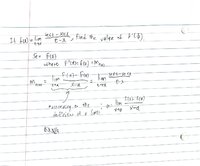I can see how if I do as you advised, the two functions align up neatly. However, doesn't x has to be the temporary variable (not t) because x is the function's input variable (that is, the function is f(x) not f(t))?
I'm not sure what you mean. I hope you know that [MATH]f[/MATH] is the same function regardless of what you call the input variable.
In the definition as you state it, [MATH]F'(a) = \lim_{x\to a}\frac{F(x)-F(a)}{x-a}[/MATH], you are finding the derivative at a specific point [MATH]a[/MATH]. The variable [MATH]a[/MATH] is fixed, and [MATH]x[/MATH] is moving toward it.
In the expression you are comparing to this, [MATH]F'(x) = \lim_{t\to x}\frac{F(t)-F(x)}{t-x}[/MATH], you are finding the derivative at a specific point [MATH]x[/MATH], by letting a variable [MATH]t[/MATH] move toward [MATH]x[/MATH]. These match up perfectly.
It is common for students to struggle a bit with this: As we take the limit, the value of [MATH]x[/MATH] is fixed, because we are finding the rate of change at a given point. But [MATH]x[/MATH] can take any value, so we end up with the derivative being a function of [MATH]x[/MATH]. This is why I said it's important to write not just your [MATH]m_{F(x)}[/MATH], which is a notation I don't think I've ever seen before, but [MATH]F'(a)[/MATH], which makes it clear where you are finding the derivative. In your notation, [MATH]x[/MATH] plays an ambiguous role; if I were to use such a notation, I would just say [MATH]m_F[/MATH], indicating that this is the slope of function [MATH]F[/MATH]. It is
not the slope at some fixed value called [MATH]x[/MATH], but at [MATH]x=a[/MATH]!


